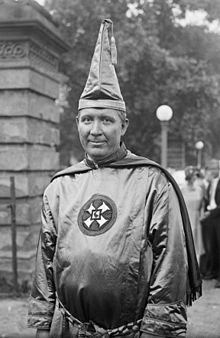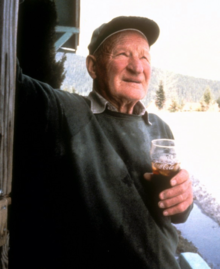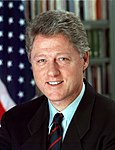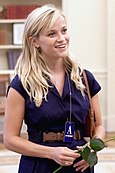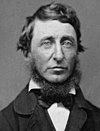Portal maintenance status: (October 2019)
|
Introduction

| |

| |
 Featured article - show another
Featured article - show another
-
Image 1
The American goldfinch (Spinus tristis) is a small North American bird in the finch family. It is migratory, ranging from mid-Alberta to North Carolina during the breeding season, and from just south of the Canada–United States border to Mexico during the winter.
The only finch in its subfamily to undergo a complete molt, the American goldfinch displays sexual dichromatism: the male is a vibrant yellow in the summer and an olive color during the winter, while the female is a dull yellow-brown shade which brightens only slightly during the summer. The male displays brightly colored plumage during the breeding season to attract a mate. (Full article...) -
Image 2
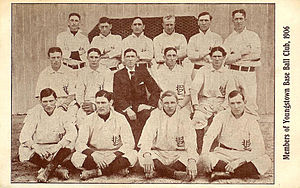
Youngstown Ohio Works (1906), with pitcher Roy Castleton seated in second row, second from left
The Youngstown Ohio Works baseball team was a minor league club that was known for winning the premier championship of the Ohio–Pennsylvania League in 1905, and for launching the professional career of pitcher Roy Castleton a year later. A training ground for several players and officials who later established careers in Major League Baseball, the team proved a formidable regional competitor and also won the 1906 league championship.
During its brief span of activity, the Ohio Works team faced challenges that reflected common difficulties within the Ohio–Pennsylvania League, including weak financial support for teams. Following a dispute over funding, the team's owners sold the club to outside investors, just a few months before the opening of the 1907 season. (Full article...) -
Image 3The 2000 Sugar Bowl was the designated Bowl Championship Series (BCS) National Championship Game for the 1999 NCAA Division I-A football season and was played on January 4, 2000, at the Louisiana Superdome in New Orleans. The Florida State Seminoles, representing the Atlantic Coast Conference, defeated the Virginia Tech Hokies, representing the Big East Conference, by a score of 46–29. With the win, Florida State clinched the 1999 BCS national championship, the team's second national championship in its history.
An estimated total of 79,280 people attended the game in person, while approximately 18.4 million US viewers watched the game on ABC television. The resulting 17.5 television rating was the third-largest ever recorded for a BCS college football game. Tickets were in high demand for the game, withs tens of thousands of fans from both teams attending, many using scalped tickets to gain entry. (Full article...) -
Image 4
Edward Rudolph Bradley Jr. (June 22, 1941 – November 9, 2006) was an American broadcast journalist and news anchor who is best known for reporting with 60 Minutes and CBS News.
After graduating from Cheyney State College, Bradley became a teacher and part-time radio disc jockey and reporter in Philadelphia, where his first major story was covering the 1964 Philadelphia race riot. He moved to New York City in 1967 and worked for WCBS as a radio news reporter. Four years later, Bradley moved to Paris, France, where he covered the Paris Peace Accords as a stringer for CBS News. In 1972, he transferred to Vietnam and covered the Vietnam War and the Cambodian Civil War, coverage for which he won Alfred I. duPont and George Polk awards. Bradley moved to Washington, D.C. following the wars and covered Jimmy Carter's first presidential campaign. He became CBS News' first African American White House correspondent, holding the position from 1976 to 1978. During this time, Bradley also anchored the Sunday night broadcast of the CBS Evening News, a position he held until 1981. (Full article...) -
Image 5
Kenesaw Mountain Landis (/ˈkɛnɪsɔː ˈmaʊntɪn ˈlændɪs/; November 20, 1866 – November 25, 1944) was an American jurist who served as a United States federal judge from 1905 to 1922 and the first Commissioner of Baseball from 1920 until his death. He is remembered for his resolution of the Black Sox Scandal, in which he expelled eight members of the Chicago White Sox from organized baseball for conspiring to lose the 1919 World Series and repeatedly refused their reinstatement requests. His iron rule over baseball in the near quarter-century of his commissionership is generally credited with restoring public confidence in the game.
Landis was born in Millville, Ohio. Raised in Indiana, he became a lawyer, and then personal secretary to Walter Q. Gresham, the new United States Secretary of State, in 1893. He returned to private practice after Gresham died in office. (Full article...) -
Image 6
The Seattle Center Monorail is an elevated straddle-beam monorail line in Seattle, Washington, United States. The 0.9-mile (1.4 km) monorail runs along 5th Avenue between Seattle Center and Westlake Center in Downtown Seattle, making no intermediate stops. The monorail is a major tourist attraction but also operates as a regular public transit service with trains every ten minutes running for up to 16 hours per day. It was constructed in eight months at a cost of $4.2 million for the 1962 Century 21 Exposition, a world's fair hosted at Seattle Center. The monorail underwent major renovations in 1988 after the southern terminal was moved from its location over Pine Street to inside the Westlake Center shopping mall.
The system retains its original fleet of two Alweg trains from the world's fair; each carries up to 450 people. It is owned by the city government, which designated the tracks and trains as a historic landmark in 2003. A private contractor has operated the system since 1994, when it replaced King County Metro, the county's public transit system. The monorail carries approximately two million people annually and earns a profit split between the contractor and the city government. The monorail usually operates with one train per track, and the entire trip takes approximately two minutes. Several major accidents have occurred during the system's half-century in service, including a train-to-train collision in 2005 on a gauntlet track near the Westlake Center terminal. (Full article...) -
Image 7

The Anbar campaign consisted of fighting between the United States military, together with Iraqi security forces, and Sunni insurgents in the western Iraqi governorate of Al Anbar. The Iraq War lasted from 2003 to 2011, but the majority of the fighting and counterinsurgency campaign in Anbar took place between April 2004 and September 2007. Although the fighting initially featured heavy urban warfare primarily between insurgents and U.S. Marines, insurgents in later years focused on ambushing the American and Iraqi security forces with improvised explosive devices (IEDs), large scale attacks on combat outposts, and car bombings. Almost 9,000 Iraqis and 1,335 Americans were killed in the campaign, many in the Euphrates River Valley and the Sunni Triangle around the cities of Fallujah and Ramadi.
Al Anbar, the only Sunni-dominated province in Iraq, saw little fighting in the initial invasion. Following the fall of Baghdad it was occupied by the U.S. Army's 82nd Airborne Division. Violence began on 28 April 2003 when 17 Iraqis were killed in Fallujah by U.S. soldiers during an anti-American demonstration. In early 2004 the U.S. Army relinquished command of the governorate to the Marines. By April 2004 the governorate was in full-scale revolt. Savage fighting occurred in both Fallujah and Ramadi by the end of 2004, including the Second Battle of Fallujah. Violence escalated throughout 2005 and 2006 as the two sides struggled to secure the Western Euphrates River Valley. During this time, Al Qaeda in Iraq (AQI) became the governorate's main Sunni insurgent group and turned the provincial capital of Ramadi into its stronghold. The Marine Corps issued an intelligence report in late 2006 declaring that the governorate would be lost without a significant additional commitment of troops. (Full article...) -
Image 8Aliso Creek flows underneath the Aliso Creek Road bridge before it enters Aliso and Wood Canyons Wilderness Park.
Aliso Creek is a 19.8-mile (31.9 km)-long, mostly urban stream in south Orange County, California. Originating in the Cleveland National Forest in the Santa Ana Mountains, it flows generally southwest and empties into the Pacific Ocean at Laguna Beach. The creek's watershed drains 34.9 square miles (90 km), and it is joined by seven main tributaries. As of 2018, the watershed had a population of 144,000 divided among seven incorporated cities.
Aliso Creek flows over highly erosive marine sedimentary rock of late Eocene to Pliocene age. What would become the Aliso Creek watershed originally lay at the bottom of the Pacific Ocean, before being uplifted as recently as 10 million years ago. About 1.2 million years ago, the San Joaquin Hills began to uplift in the path of Aliso Creek. Occasionally swollen by wetter climates during glacial periods, the creek carved the deep water gap known today as Aliso Canyon, the main feature of Aliso and Wood Canyons Wilderness Park. (Full article...) -
Image 9Groundhog Day is a 1993 American fantasy romantic comedy film directed by Harold Ramis from a screenplay by him and Danny Rubin. Starring Bill Murray, Andie MacDowell, and Chris Elliott, it tells the story of a cynical television weatherman covering the annual Groundhog Day event in Punxsutawney, Pennsylvania, who becomes trapped in a time loop, forcing him to relive February 2 repeatedly. The film also features Stephen Tobolowsky, Brian Doyle-Murray, Marita Geraghty, Angela Paton, Rick Ducommun, Rick Overton, and Robin Duke in supporting roles.
Rubin conceived the outline of Groundhog Day in the early 1990s. He wrote it as a spec script to gain meetings with producers for other work. It eventually came to the attention of Ramis, who worked with Rubin to make his idea less dark in tone and more palatable to a general audience by enhancing the comedy. After being cast, Murray clashed with Ramis over the script; Murray wanted to focus on the philosophical elements, whereas Ramis concentrated on the comedic aspects. Principal photography took place from March to June 1992, almost entirely in Woodstock, Illinois. Filming was difficult, in part because of bitterly cold weather but also because of the ongoing conflict between Ramis and Murray. (Full article...) -
Image 10
Operation Inmate was an attack by the British Pacific Fleet against Japanese positions on Truk Atoll in the central Pacific Ocean during the Second World War. The attacks against the isolated islands on 14 and 15 June 1945 were conducted to provide combat experience for the aircraft carrier HMS Implacable and several of the fleet's cruisers and destroyers ahead of their involvement in more demanding operations off the Japanese home islands.
On 14 June 1945 British aircraft conducted a series of raids against Japanese positions at Truk. The next morning, several islands were bombarded by British and Canadian cruisers, though only one of the four warships involved achieved any success. Further air strikes took place in the afternoon and night of 15 June before the Allied force returned to its base. (Full article...) -
Image 11
Hiram Wesley Evans (September 26, 1881 – September 14, 1966) was the Imperial Wizard of the Ku Klux Klan, an American white supremacist group, from 1922 to his resignation in 1939. A native of Alabama, Evans attended Vanderbilt University and became a dentist. He operated a small, moderately successful practice in Texas until 1920, when he joined the Klan's Dallas chapter. He quickly rose through the ranks and was part of a group that ousted William Joseph Simmons from the position of Imperial Wizard, the national leader, in November 1922. Evans succeeded him and sought to transform the group into a political power.
Evans had led the kidnapping and torture of a black man while leader of the Dallas Klan, but as Imperial Wizard, he publicly discouraged vigilante actions for fear that they would hinder his attempts to gain political influence. In 1923, Evans presided over the largest Klan gathering in history, attended by over 200,000, and endorsed several successful candidates in 1924 elections. He moved the Klan's headquarters from Atlanta to Washington, D.C., and organized a march of 30,000 members, the largest march in the organization's history, on Pennsylvania Avenue. Evans's efforts notwithstanding, the Klan was buffeted by damaging publicity in the early 1920s, partially because of leadership struggles between Evans and his rivals, which hindered his political efforts. (Full article...) -
Image 12

The tuxedo dress, pictured at Fashioning Masculinities: The Art of Menswear, Victoria and Albert Museum, March 2022
American actor Billy Porter wore a tuxedo dress in black velvet designed by Christian Siriano on the red carpet of the 91st Academy Awards on February 24, 2019. At the time, Porter had recently come into public view for his breakout role in the FX television series Pose and had been receiving attention for his boundary-pushing red carpet attire during the 2018–19 film awards season. Following his appearance at the 76th Golden Globe Awards in a custom silver suit with fuchsia-lined cape, he was invited to host red carpet interviews at the upcoming Oscars pre-show. Porter approached Siriano and together they conceived the tuxedo gown.
The gown was well received by fashion journalists, who highlighted its elegant design. It cemented Porter's status as a celebrity and as a fashion icon. Critics have described it as a favorite Oscars dress and one of Porter's most fashionable red carpet looks. Porter considers the outfit a piece of political art intended to drive a conversation about men's fashion and masculinity, for which it has received praise from fashion writers, academics, and the general public, as well as criticism from conservative commentators. (Full article...) -
Image 13Here Is Mariah Carey, also known as Mariah Carey or This Is Mariah Carey, is the third video album by American singer Mariah Carey. It presents Carey performing live at Proctor's Theatre in Schenectady, New York, in July 1993, and also includes non-concert footage. Carey performs ten songs during the video; four are from her third studio album Music Box (1993), which Columbia Records commissioned Here Is Mariah Carey to promote. She is sporadically accompanied by a band, choir, dancers, and string musicians. In creating the stage for the performance, production designers sought inspiration from works by Boris Aronson and Josep Maria Jujol. Lawrence Jordan, who collaborated with Carey on previous occasions, directed the hour-long video.
Approximately 4,500 people attended tapings at Proctor's Theater, and 19 million watched it on television network NBC during its original broadcast on November 25, 1993. Columbia Music Video released it on VHS five days later to generally positive reviews from critics. Although they complimented Carey's voice, many felt the non-concert scenes were redundant. Here Is Mariah Carey peaked at number four on the United States video album chart published by Billboard. Earning a Platinum certification from the Recording Industry Association of America, it was one of the best-selling video albums of 1994 and 1995 in that country. The video also spent six weeks at number one on the Official Charts Company's music videos chart in the United Kingdom. (Full article...) -
Image 14

Nativity, c. mid-1450s. Oil on wood, 127.6 cm × 94.9 cm (50.2 in × 37.4 in), National Gallery of Art, Washington, D.C.
The Nativity is a devotional mid-1450s oil-on-wood panel painting by the Early Netherlandish painter Petrus Christus. It shows a nativity scene with grisaille archways and trompe-l'œil sculptured reliefs. Christus was influenced by the first generation of Netherlandish artists, especially Jan van Eyck and Rogier van der Weyden, and the panel is characteristic of the simplicity and naturalism of art of that period. Placing archways as a framing device is a typical van der Weyden device, and here likely borrowed from that artist's Altar of Saint John and Miraflores Altarpiece. Yet Christus adapts these painterly motifs to a uniquely mid-15th century sensibility, and the unusually large panel – perhaps painted as a central altarpiece panel for a triptych – is nuanced and visually complex. It shows his usual harmonious composition and employment of one-point-perspective, especially evident in the geometric forms of the shed's roof, and his bold use of color. It is one of Christus's most important works. Max Friedländer definitely attributed the panel to Christus in 1930, concluding that "in scope and importance, ※ is superior to all other known creations of this master."
The overall atmosphere is one of simplicity, serenity and understated sophistication. It is reflective of the 14th-century Devotio Moderna movement, and contains complex Christian symbolism, subtly juxtaposing Old and New Testament iconography. The sculpted figures in the archway depict biblical scenes of sin and punishment, signaling the advent of Christ's sacrifice, with an over-reaching message of the "Fall and Redemption of humankind". Inside the archway, surrounded by four angels, is the Holy Family; beyond, a landscape extends into the far background. (Full article...) -
Image 15Operation Crossroads was a pair of nuclear weapon tests conducted by the United States at Bikini Atoll in mid-1946. They were the first nuclear weapon tests since Trinity on July 16, 1945, and the first detonations of nuclear devices since the atomic bombing of Nagasaki on August 9, 1945. The purpose of the tests was to investigate the effect of nuclear weapons on warships.
The Crossroads tests were the first of many nuclear tests held in the Marshall Islands, and the first to be publicly announced beforehand and observed by an invited audience, including a large press corps. They were conducted by Joint Army/Navy Task Force One, headed by Vice Admiral William H. P. Blandy rather than by the Manhattan Project, which had developed nuclear weapons during World War II. A fleet of 95 target ships was assembled in Bikini Lagoon and hit with two detonations of Fat Man plutonium implosion-type nuclear weapons of the kind dropped on Nagasaki in 1945, each with a yield of 23 kilotons of TNT (96 TJ). (Full article...) -
Image 16
United States General of the Army Douglas MacArthur shakes hands with US president Harry Truman at the Wake Island Conference, seven months before Truman relieved MacArthur from command.
On 11 April 1951, U.S. president Harry S. Truman relieved General of the Army Douglas MacArthur of his commands after MacArthur made public statements that contradicted the administration's policies. MacArthur was a popular hero of World War II who was then commander of United Nations Command forces fighting in the Korean War, and his relief remains a controversial topic in the field of civil–military relations.
MacArthur led the Allied forces in the Southwest Pacific during World War II, and after the war was in charge of the occupation of Japan. In the latter role, MacArthur was able to accumulate considerable power over the civil administration of Japan. Eventually, he gained a level of political experience that was unprecedented and yet to be repeated by anyone else actively serving as a flag officer in the U.S. military. (Full article...) -
Image 17
Julie Anne Smith (born December 3, 1960), known professionally as Julianne Moore, is an American actress. Prolific in film since the early 1990s, she is particularly known for her portrayals of emotionally troubled women in independent films, as well as for her roles in blockbusters. She is the recipient of numerous accolades, including an Academy Award, a British Academy Film Award, two Golden Globe Awards, and two Emmy Awards.
After studying theatre at Boston University, Moore began acting in television. From 1985 to 1988, she was a regular in the soap opera As the World Turns, earning a Daytime Emmy Award. She made her film debut in 1990, and continued to play supporting roles throughout the early 1990s. Moore made her breakthrough with Robert Altman's Short Cuts (1993), followed by a critically acclaimed performance in Todd Haynes' Safe (1995). Starring roles in the blockbusters Nine Months (1995) and The Lost World: Jurassic Park (1997) established her as a Hollywood leading lady. (Full article...) -
Image 18
Harry R. Truman (October 1896 – May 18, 1980) was an American businessman, bootlegger, and prospector. He
lived near Mount St. Helens, an active volcano in the state of Washington, and was the owner and caretaker of Mount St. Helens Lodge at Spirit Lake near the base of the mountain. Truman came to fame as a folk hero in the months leading up to the volcano's 1980 eruption after refusing to leave his home despite evacuation orders. He was killed by a pyroclastic flow that overtook his lodge and buried the site under 150 ft (46 m) of volcanic debris.
After Truman's death, his family and friends reflected on his love for the mountain. In 1981, Art Carney portrayed Truman in the docudrama film St. Helens. He was commemorated in a book by his niece, and also in various pieces of music, including songs by Headgear, Billy Jonas, and Shawn Wright and the Brothers Band. (Full article...) -
Image 19The 4th Missouri Infantry Regiment was formed on April 28, 1862, and served in the Confederate States Army during the American Civil War. The infantry regiment did not see action at the Battle of Farmington on May 9, and the Battle of Iuka on September 19 despite being part of the Confederate force present at those battles. As part of Brigadier General Martin E. Green's brigade, the regiment participated in three charges against Union lines on October 3, 1862, during the Second Battle of Corinth. The following day, the regiment, along with the rest of Green's brigade, attacked the new Union lines. Despite initial success, the attack was repulsed by a Union counterattack. The regiment ceased to exist as a separate unit when it was combined with the 1st Missouri Infantry Regiment on November 7, 1862, to form the 1st and 4th Missouri Infantry Regiment (Consolidated).
The combined unit served in the Vicksburg campaign in 1863, before surrendering at the end of the siege of Vicksburg. After undergoing a prisoner exchange, the men rejoined the Confederate Army and served in the Atlanta Campaign and the Battle of Franklin in 1864, still as part of the 1st and 4th Missouri Infantry Regiment (Consolidated). On May 9, 1865, near the end of the war, the consolidated regiment surrendered during the Battle of Fort Blakely, ending the unit's existence. The 4th Missouri Infantry's battle flag is displayed at the American Civil War Museum. (Full article...) -
Image 20
Jethro Exum Sumner (c. 1733 – c. March 18, 1785) was a senior officer of the Continental Army during the American Revolutionary War. Born in Virginia, Sumner's military service began in the French and Indian War as a member of the state's Provincial forces. After the conclusion of that conflict, he moved to Bute County, North Carolina, where he acquired a substantial area of land and operated a tavern. He served as Sheriff of Bute County, but with the coming of the American Revolution, he became a strident patriot, and was elected to North Carolina's Provincial Congress.
Sumner was named the commanding officer of the 3rd North Carolina Regiment of the North Carolina Line, a formation of the Continental Army, in 1776, and served in both the Southern theater and Philadelphia campaign. He was one of five brigadier generals from North Carolina in the Continental Army, in which capacity he served between 1779 and 1783. He served with distinction in the battles of Stono Ferry and Eutaw Springs, but recurring bouts of poor health often forced him to play an administrative role, or to convalesce in North Carolina. Following a drastic reduction in the number of North Carolinians serving with the Continental Army, Sumner became a general in the state's militia but resigned in protest after the North Carolina Board of War awarded overall command of the militia to William Smallwood, a Continental Army general from Maryland. At the end of the war in 1783, Sumner helped to establish the North Carolina Chapter of the Society of the Cincinnati, and became its first president. He died in 1785 with extensive landholdings and 35 slaves. (Full article...) -
Image 21Chief U.S. Marshal James McShane (left) and U.S. Assistant Attorney General for Civil Rights John Doar (right), escorting James Meredith to class at Ole Miss after the riot.
The Ole Miss riot of 1962 (September 30 – October 1, 1962), also known as the Battle of Oxford, was a violent disturbance that occurred at the University of Mississippi—commonly called Ole Miss—in Oxford, Mississippi, as Segregationist rioters sought to prevent the enrollment of African American applicant James Meredith. President John F. Kennedy eventually quelled the riot by mobilizing more than 30,000 troops, the most for a single disturbance in United States history.
In the wake of the Supreme Court's 1954 decision Brown v. Board of Education, Meredith tried to integrate Ole Miss by applying in 1961. When he informed the university that he was African American, his admission was delayed and obstructed, first by school officials and then by Mississippi Governor Ross Barnett. In a bid to block his enrollment, Barnett even had Meredith temporarily jailed. Multiple attempts by Meredith, accompanied by federal officials, to enroll were physically blocked. Hoping to avoid violence and ensure Meredith's enrollment, President Kennedy and Attorney General Robert F. Kennedy had a series of unproductive telephone negotiations with Barnett. (Full article...) -
Image 22British and Canadian forces attacking Arnold's column in the Sault-au-Matelot, Charles William Jefferys
The Battle of Quebec (French: Bataille de Québec) was fought on December 31, 1775, between American Continental Army forces and the British defenders of Quebec City early in the American Revolutionary War. The battle was the first major defeat of the war for the Americans, and it came with heavy losses. General Richard Montgomery was killed, Benedict Arnold was wounded, and Daniel Morgan and more than 400 men were taken prisoner. The city's garrison, a motley assortment of regular troops and militia led by Quebec's provincial governor, General Guy Carleton, suffered a small number of casualties.
Montgomery's army had captured Montreal on November 13, and early in December they became one force that was led by Arnold, whose men had made an arduous trek through the wilderness of northern New England. Governor Carleton had escaped from Montreal to Quebec, the Americans' next objective, and last-minute reinforcements arrived to bolster the city's limited defenses before the attacking force's arrival. Concerned that expiring enlistments would reduce his force, Montgomery made the end-of-year attack in a blinding snowstorm to conceal his army's movements. The plan was for separate forces led by Montgomery and Arnold to converge in the lower city before scaling the walls protecting the upper city. Montgomery's force turned back after he was killed by cannon fire early in the battle, but Arnold's force penetrated further into the lower city. Arnold was injured early in the attack, and Morgan led the assault in his place before he became trapped in the lower city and was forced to surrender. Arnold and the Americans maintained an ineffectual blockade of the city until spring, when British reinforcements arrived. (Full article...) -
Image 23
Tropical Storm Henri was a moderate tropical storm that formed in the 2003 Atlantic hurricane season. The eighth storm of the season, Henri was one of six tropical cyclones to hit the United States in the year. Henri formed from a tropical wave in the Gulf of Mexico in early September, and crossed over Florida as a tropical depression. Its remnants later moved into the Mid-Atlantic before dissipating completely.
Henri caused little damage as a tropical cyclone. In Florida, it dropped heavy rainfall, though damage was limited to minor flooding damage. In Delaware and Pennsylvania, damage was greater, where heavy rainfall damaged hundreds of houses and businesses. The resulting floods in Delaware were described as a 1 in 500 year event. The total damage by Henri along its path amounted to $19.6 million (2003 USD, $21.5 million 2006 USD), but no deaths were reported. (Full article...) -
Image 24The Livestock Conservancy, formerly known as the American Livestock Breeds Conservancy (ALBC) and prior to that, the American Minor Breeds Conservancy, is a nonprofit organization focused on preserving and promoting rare breeds, also known as "heritage breeds" of livestock. Founded in 1977, through the efforts of livestock breed enthusiasts concerned about the disappearance of many of the US's heritage livestock breeds, The Livestock Conservancy was the pioneer livestock preservation organization in the United States, and remains a leading organization in that field. It has initiated programs that have saved multiple breeds from extinction, and works closely with similar organizations in other countries, including Rare Breeds Canada. With 3,000 members, a staff of eleven and a 19-member board of directors, the organization has an operating budget of over a million dollars.
The Livestock Conservancy maintains a conservation priority list that divides endangered breeds of horses, asses, sheep, goats, cattle, rabbits, pigs and poultry into five categories based on population numbers and historical interest. The organization has published several books, and works with breed registries and other groups on several aspects of breed preservation, including genetic testing, historical documentation, animal rescue and marketing. Preservation of genetic material is of special interest to the Conservancy, and for a period of time it maintained a gene bank that was later transferred to the United States Department of Agriculture. It has also developed and published several heritage definitions, including parameters for heritage breeds of cattle and poultry. (Full article...) -
Image 25
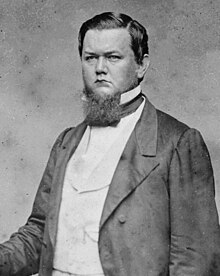
Henry Cornelius Burnett (October 25, 1825 – October 1, 1866) was an American politician who served as a Confederate States senator from Kentucky from 1862 to 1865. From 1855 to 1861, Burnett served four terms in the United States House of Representatives. A lawyer by profession, Burnett had held only one public office—circuit court clerk—before being elected to Congress. He represented Kentucky's 1st congressional district immediately prior to the Civil War. This district contained the entire Jackson Purchase region of the state, which was more sympathetic to the Confederate cause than any other area of Kentucky. Burnett promised the voters of his district that he would have President Abraham Lincoln arraigned for treason. Unionist newspaper editor George D. Prentice described Burnett as "a big, burly, loud-mouthed fellow who is forever raising points of order and objections, to embarrass the Republicans in the House".
Besides championing the secession in Congress, Burnett also worked within Kentucky to bolster the state's support of the Confederacy. He presided over a sovereignty convention in Russellville in 1861 that formed a Confederate government for the state. The delegates to this convention chose Burnett to travel to Richmond, Virginia to secure Kentucky's admission to the Confederacy. Burnett also raised a Confederate regiment at Hopkinsville, Kentucky, and briefly served in the Confederate States Army. Camp Burnett, a Confederate recruiting post two miles west of Clinton in Hickman County, Kentucky, was named after him. (Full article...)
Did you know (auto-generated) - load new batch

- ... that the Chicago Community Bond Fund sought to put itself out of business by eliminating cash bail?
- ... that in 1943, the United States Army conducted a large-scale battle near Stauffer, Oregon, as part of the Oregon Maneuver training exercise preparing troops for combat in World War II?
- ... that during his mayoralty, Fiorello La Guardia appointed the first black woman judge in the United States?
- ... that East Timor uses the United States dollar, but produces its own coins to facilitate smaller transactions?
- ... that Amazon Labor Union founder Chris Smalls was one of the leaders in the first successful effort to unionize Amazon warehouse workers in the United States?
- ... that Red Clay State Historic Park was the last capital of the Cherokee Nation in the eastern United States?
- ... that, upon ordination, Earl K. Fernandes will be the first Indian-American Latin Catholic bishop in the United States?
- ... that Newark Liberty International Airport was the first commercial airport in the United States with a paved airstrip?
Selected society biography - show another
Clinton was born and raised in Arkansas. He graduated from Georgetown University in 1968, and later from Yale Law School, where he met his future wife, Hillary Rodham. After graduating from law school, Clinton returned to Arkansas and won election as state attorney general, followed by two non-consecutive tenures as Arkansas governor. As governor, he overhauled the state's education system and served as chairman of the National Governors Association. Clinton was elected president in the 1992 election, defeating the incumbent Republican Party president George H. W. Bush and the independent businessman Ross Perot. He became the first president to be born in the Baby Boomer generation. (Full article...)
Selected image - show another
-
Image 1Artist: Daniel A. Jenks; Restoration: Papa Lima WhiskeyA drawing of travelers on the California Trail, one of the major emigrant trails across the Western United States used by over 250,000 people heading west during the California Gold Rush. This, combined with those coming from the east across the Isthmus of Panama or around Cape Horn, greatly increased the population of California, and spurred the movement to make it the 31st U.S. state.
-
Image 2Restoration: Adam Cuerden"Join, or Die", a 1754 editorial cartoon by Benjamin Franklin, a woodcut showing a snake severed into eight pieces, with each segment labeled with the initials of a British American colony or region (not all colonies are represented). It was originally about the importance of colonial unity against France during the French and Indian War, and re-used in the years ahead of the American Revolution to signify unity against Great Britain.
-
Image 3Lithographer: Joseph E. Baker; Restoration: Lise BroerA fanciful 1892 lithograph of the Salem witch trials. The trials, which took place between February 1692 and May 1693 in colonial Massachusetts, involved people accused of witchcraft, and have been used as a cautionary tale about the dangers of religious extremism, false accusations, lapses in due process, and governmental intrusion on individual liberties.
-
Image 4Engraving credit: W. W. Rice, after Robert Walter Weir; restored by Andrew ShivaArtists producing art and engraving on United States banknotes began experimenting with copper plates as an alternative to wood engraving in the early 18th century. Applied to the production of paper currency, copper-plate engraving, and later steel engraving, enabled banknote design and printing to rapidly advance during the 19th century. This vignette, engraved by W. W. Rice, appeared on certain United States fifty-dollar bills issued in 1875. Produced for the Department of the Treasury's Bureau of Engraving and Printing, the engraving is of Robert Walter Weir's painting Embarkation of the Pilgrims, which hangs in the United States Capitol rotunda. It depicts the Pilgrims on the deck of the ship Speedwell as they depart Delfshaven in South Holland on July 22, 1620. They met additional colonists at Southampton, England, and transferred to the Mayflower before sailing to the New World.
-
Image 5Photo credit: Daniel MayerBryce Canyon National Park is a national park located in southwestern Utah in the United States. Contained within the park is Bryce Canyon, a giant natural amphitheater created by erosion along the eastern side of the Paunsaugunt Plateau. Bryce Canyon was not formed from erosion initiated from a central stream, meaning it technically is not a canyon.
-
Image 6Photo credit: US Bureau of ReclamationThe Central Arizona Project Aqueduct is a diversion canal in Arizona in the United States. The aqueduct diverts water from the Colorado River from Lake Havasu City into central and southern Arizona.
The Central Arizona Project is a multipurpose water resource development and management project that was designed to provide water to nearly one million acres of Indian and non-Indian irrigated agricultural land areas as well as municipal water for several Arizona communities. -
Image 7Satellite image credit: NASAPearl Harbor is a complex embayment on the island of O'ahu, Hawai'i, west of Honolulu. Originally an extensive, shallow inlet or bay called Wai Momi, meaning "Water of Pearl", or Pu'uloa, by the Hawaiians, Pearl Harbor was regarded as the home of the shark goddess Ka'ahupahau and her brother Kahi'uka. Pearl Harbor is well known for the attack by Japan in 1941 which brought the United States into World War II.
-
Image 8L-to-R: Allan Pinkerton, Abraham Lincoln, Maj. Gen. John A. McClernandPhoto credit: Alexander GardnerAllan Pinkerton (left), President Abraham Lincoln (center), and Major General John A. McClernand (right). This photo was taken not long after the Civil War's first battle on northern soil in Antietam, Maryland, on October 3, 1862. Pinkerton was the head of Union Intelligence Services at the time. He also, allegedly, foiled an assassination attempt against Lincoln. His wartime work was critical in Pinkerton's development, which he later used to pioneer the American private detective industry when he formed the Pinkerton National Detective Agency.
-
Image 9Destruction caused by a natural gas pipeline explosion, which took place on September 9, 2010, in San Bruno, California, a suburb of San Francisco. Defective welds in the pipeline caused the gas to leak, which then caused the explosion. The resulting fire was fed by the natural gas, hampering emergency efforts, and the fire was not contained until the following day.
-
Image 10Photo credit: McPherson and OliverScars of a whipped slave named Peter, photo taken at Baton Rouge, Louisiana, 1863. In his own words, "Overseer Artayou Carrier whipped me. I was two months in bed sore from the whipping. My master come after I was whipped; he discharged the overseer." The slave pictured here escaped from a plantation in Mississippi, made his way to Union forces, and joined the U.S. Army at the Union garrison located at Baton Rouge.
Slavery in the United States began soon after the English colonists first settled in North America. From about the 1640s until 1865, people of African descent were legally enslaved within the boundaries of the present U.S. mostly by whites, but also by a comparatively tiny number of American Indians and free blacks. By 1860, the slave population in the U.S. had grown to 4 million. -
Image 11Painting credit: Heinrich C. BerannHeinrich C. Berann (1915–1999) was an Austrian painter and cartographer. He achieved world fame with his panoramic maps that combined modern cartography with classical painting. Towards the end of his life, he created four panoramic posters of national parks which were published by the U.S. National Park Service. This 1994 panorama shows Denali National Park and Preserve in central Alaska, with Denali, the highest mountain on the continent, and the glaciers on its southern flanks.
-
Image 12Banknote design credit: United States Department of the Treasury; photographed by the National Numismatic CollectionFractional currency, also referred to as shinplasters, was introduced by the United States federal government following the outbreak of the Civil War. These low-denomination banknotes of the U.S. dollar were in use between 21 August 1862 and 15 February 1876; they were issued in denominations of 3, 5, 10, 15, 25 and 50 cents across five issuing periods. The notes could be redeemed by the U.S. Postal Service for the face value in postage stamps.
This picture shows a third-issue fifty-cent fractional currency note (one of three variants of this denomination), issued by the United States Department of the Treasury between 5 December 1864 and 16 August 1869, featuring a portrait of Francis E. Spinner, then treasurer of the United States, on the obverse. This banknote is in the National Numismatic Collection of the Smithsonian Institution's National Museum of American History. -
Image 13Seals of the U.S. states (1876)Image credit: A.J. Connell Litho.A lithograph from 1876, showing the seals of the then-47 U.S. states and territories as well as the District of Columbia. Some of these seals have changed since this image was created.
-
Image 14Artist: Peter F. Rothermel; Engraver: Robert Whitechurch; Restoration: Lise Broer and JujutacularU.S. Senator Henry Clay gives a speech in the Old Senate Chamber calling for compromise on the issues dividing the United States. The result was the Compromise of 1850, a package of five bills, the first two of which were passed on September 9. Ironically, these led to a breakdown in the spirit of compromise in the years preceding the Civil War, particularly after the deaths of Clay and Daniel Webster.
-
Image 15Photograph: Unknown; Restoration: Chick BowenA pile of American bison skulls, waiting to be ground for fertilizer; a man stands atop the pile, with another in front of it. Bison, long a staple of Plains Indian tribal culture, were aggressively hunted by European settlers in the United States, nearly leading to the extinction of the species.
Selected culture biography - show another
Witherspoon married actor and Cruel Intentions co-star Ryan Phillippe in 1999; they have two children, Ava and Deacon. The couple separated at the end of 2006 and divorced in October 2007. Witherspoon owns a production company, Type A Films, and she is actively involved in children's and women's advocacy organizations. She serves on the board of the Children's Defense Fund (CDF), and was named Global Ambassador of Avon Products in 2007, serving as honorary chair of the charitable Avon Foundation.
Selected location - show another
In 1630, Puritan colonists from England founded the city on the Shawmut Peninsula. During the American Revolution the Boston Massacre, the Boston Tea Party, the Battle of Bunker Hill and the Siege of Boston all occurred within the city and surrounding areas. After American independence was attained Boston became a major shipping port and manufacturing center, and its rich history now attracts 16.3 million visitors annually. The city was the site of America's first public school, Boston Latin School (1635), and first college, Harvard College (1636), in neighboring Cambridge. Boston was also home to the first subway system in the United States.
Through land reclamation and municipal annexation, Boston has expanded beyond the peninsula. With many colleges and universities within the city and surrounding area, Boston is a center of higher education and a center for health care. The city's economy is also based on research, finance, and technology — principally biotechnology.
Selected quote - show another
| I know not what course others may take, but as for me, give me Liberty, or give me Death!
— Patrick Henry, Give me Liberty, or give me Death! speech, March 23, 1775
|
Anniversaries for July 12
- 1817 – American author, poet, abolitionist, naturalist, tax resister, development critic, and leading transcendentalist Henry David Thoreau (pictured) was born.
- 1812 – The United States invades Canada at Windsor, Ontario as part of the War of 1812.
- 1862 – The Medal of Honor, the highest military decoration awarded by the United States government, is authorized by the Congress.
- 1917 – The Bisbee Deportation occurs as vigilantes kidnap] and deport nearly 1,300 striking miners and others from Bisbee, Arizona.
- 1967 – The Newark riots, which were sparked when two white policemen beat an African-American cabdriver until he needed to be hospitalized, began in Newark, New Jersey. The riots would leave 26 dead, 725 injured, and cause ten million dollars in damages.
- 1979 – Disco Demolition Night, a promotional event which involved the demolition of a crate of disco music records, is held at Comiskey Park, in Chicago, Illinois.
Selected cuisines, dishes and foods - show another
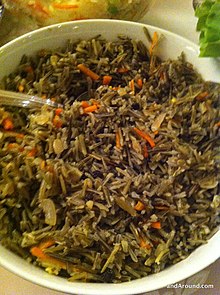
Selected panorama - show another
| Credit: Mila Zinkova |
More did you know? - show different entries
- ... that the two largest Rocky Mountain Douglas-fir trees in the United States survived the B&B Complex Fires (pictured) that burned 90,769 acres (367.33 km) of forest in the Cascade Range of Oregon?
- ... that in 1929 the Hudson Motor Car Company ranked third in total U.S. production by targeting budget minded buyers, but introduced the Greater Eight, a premium line of cars, at the height of the Depression?
- ... that Ben Cooper, Inc., the "Halston of Halloween", said it sold a scary 4 million Halloween costumes in the United States in 1990?
Topics
Categories

Featured content
List articles
|
Culture Education Economy |
Geography Government
History |
Law Media Natural history |
People Protected areas Religion Transportation |
Tasks
Featured article candidatesTotal pages in content type is 10 Featured list candidatesTotal pages in content type is 6 Good article nominees
Total pages in content type is 79 | ||||
|
To create
To discuss on Articles for deletion
To expand To destub
|
Assessment requests New articles Most Popular pages To find images |
Maintenance and cleanup
Other issues
| ||
Related portals
State-related
Region or city-related
Sports-related
Transportation-related
Other US-related
Nearby areas
WikiProjects
Associated Wikimedia
The following Wikimedia Foundation sister projects provide more on this subject:
-
Commons
Free media repository -
Wikibooks
Free textbooks and manuals -
Wikidata
Free knowledge base -
Wikinews
Free-content news -
Wikiquote
Collection of quotations -
Wikisource
Free-content library -
Wikiversity
Free learning tools -
Wikivoyage
Free travel guide -
Wiktionary
Dictionary and thesaurus
More portals
Text is available under the Creative Commons Attribution-ShareAlike License. Additional terms may apply.
↑








